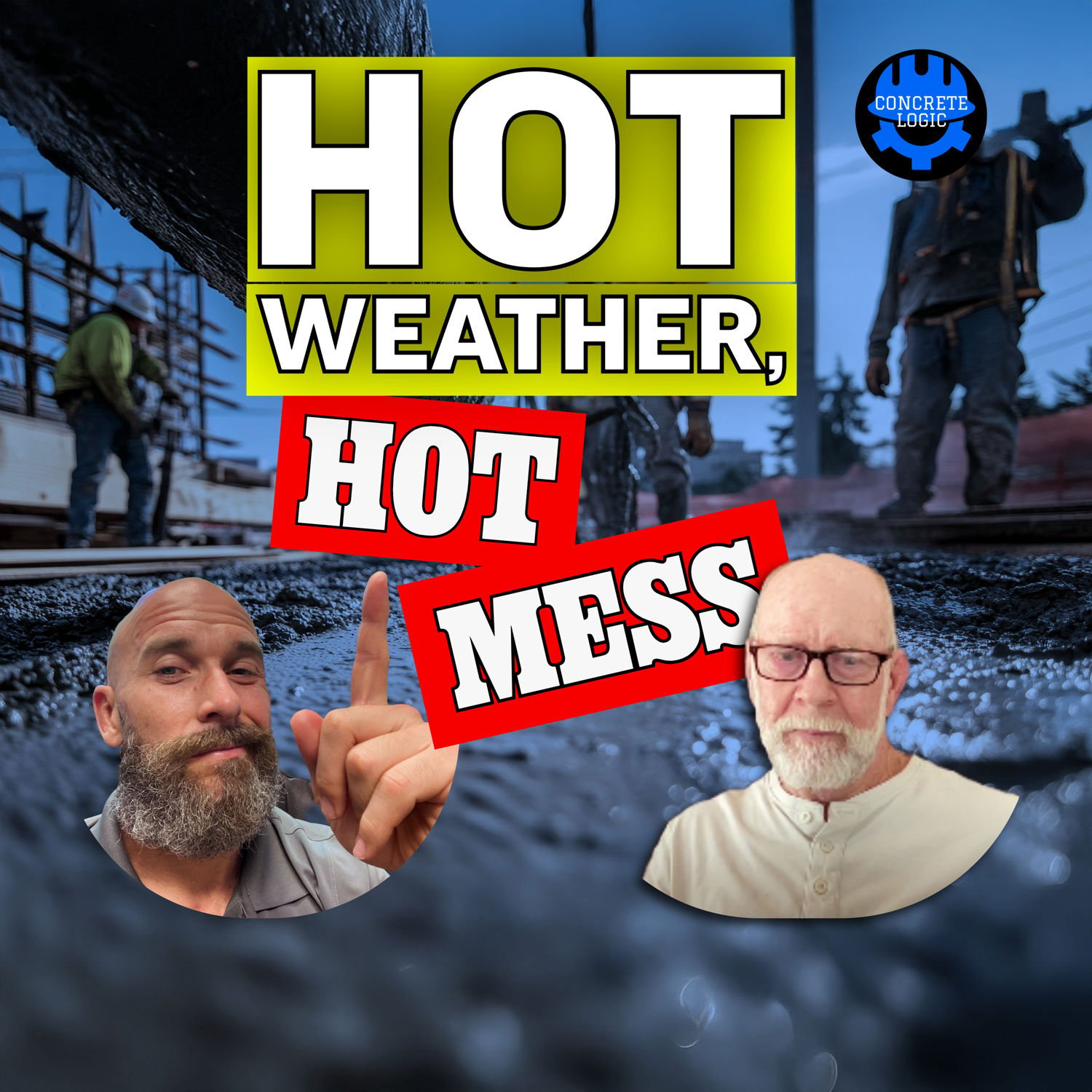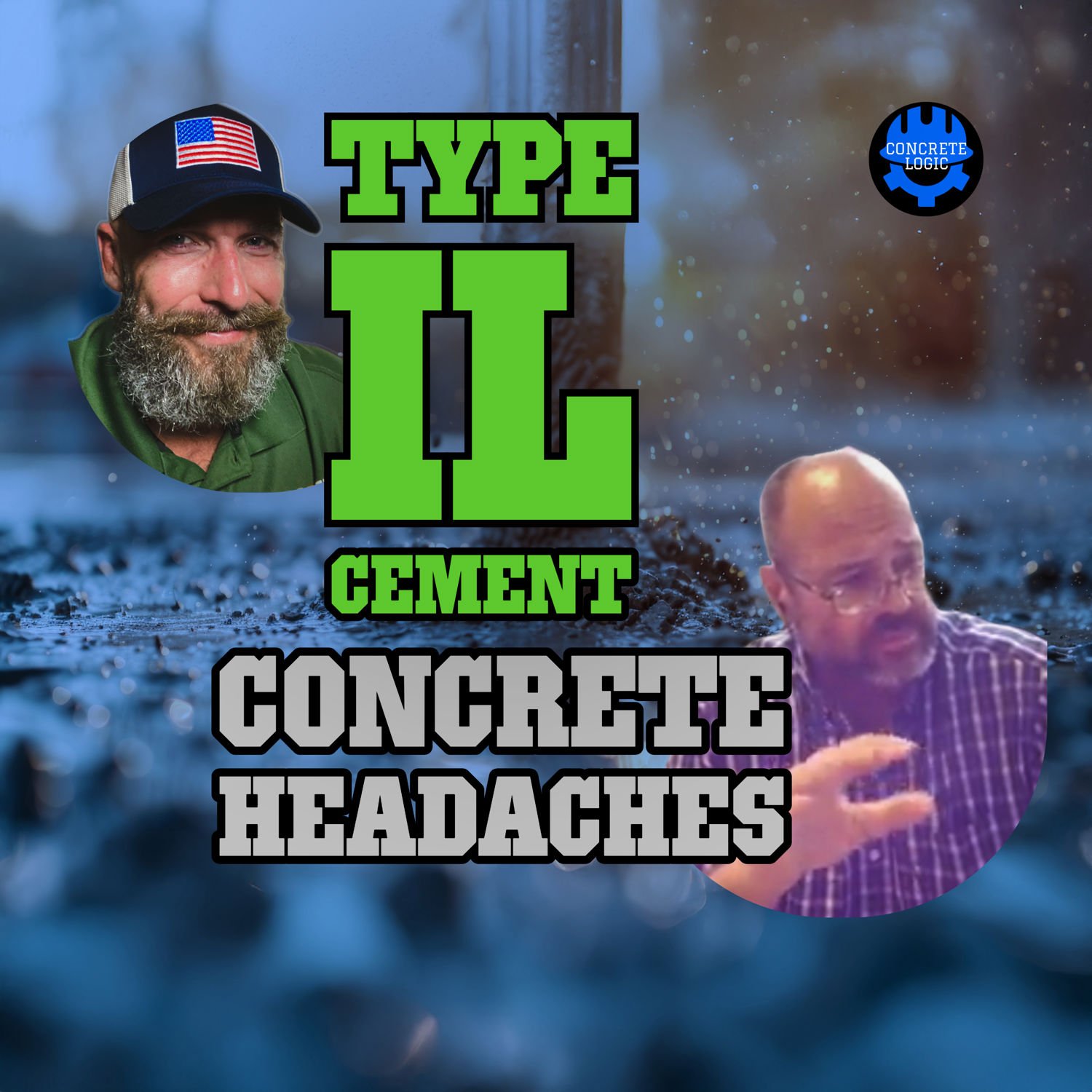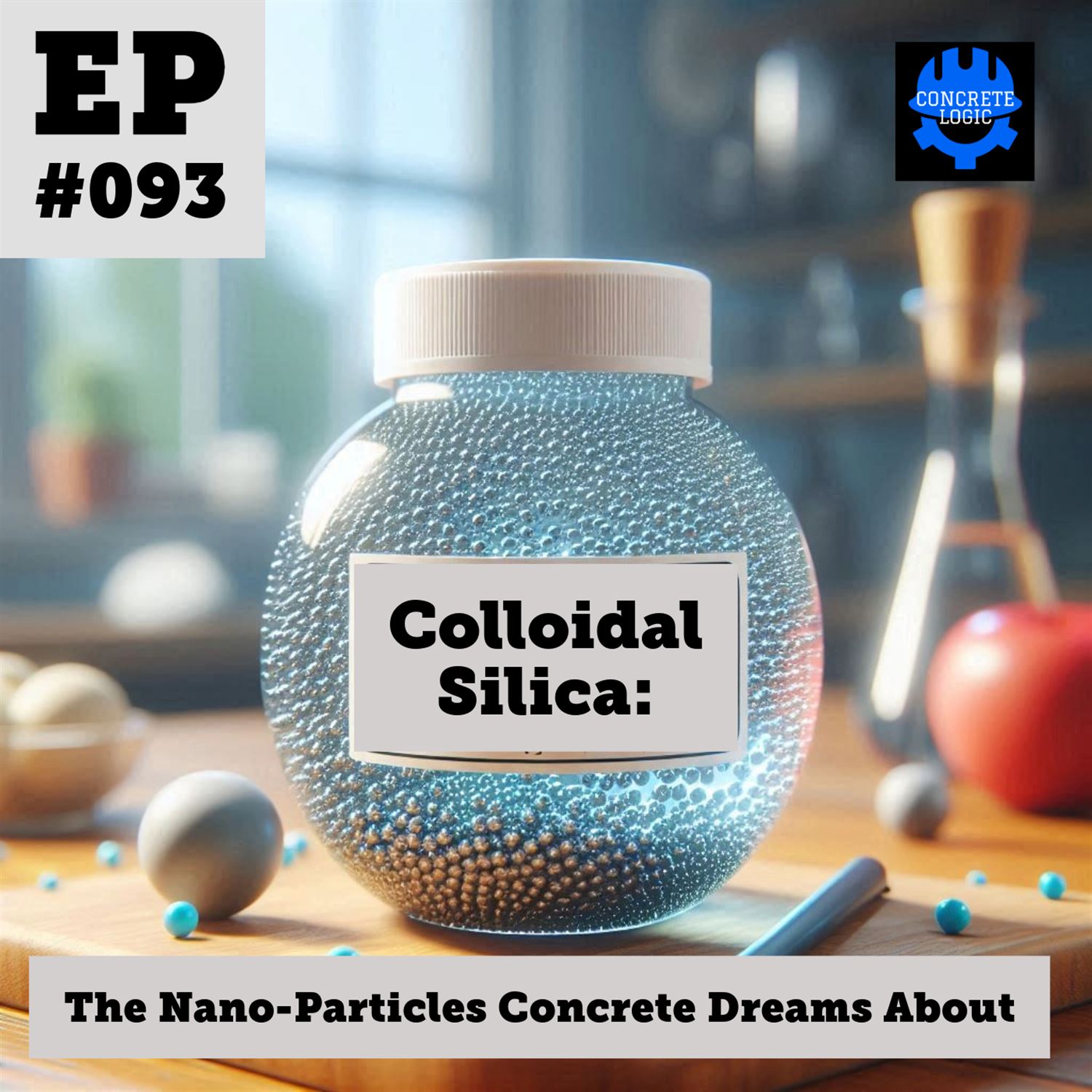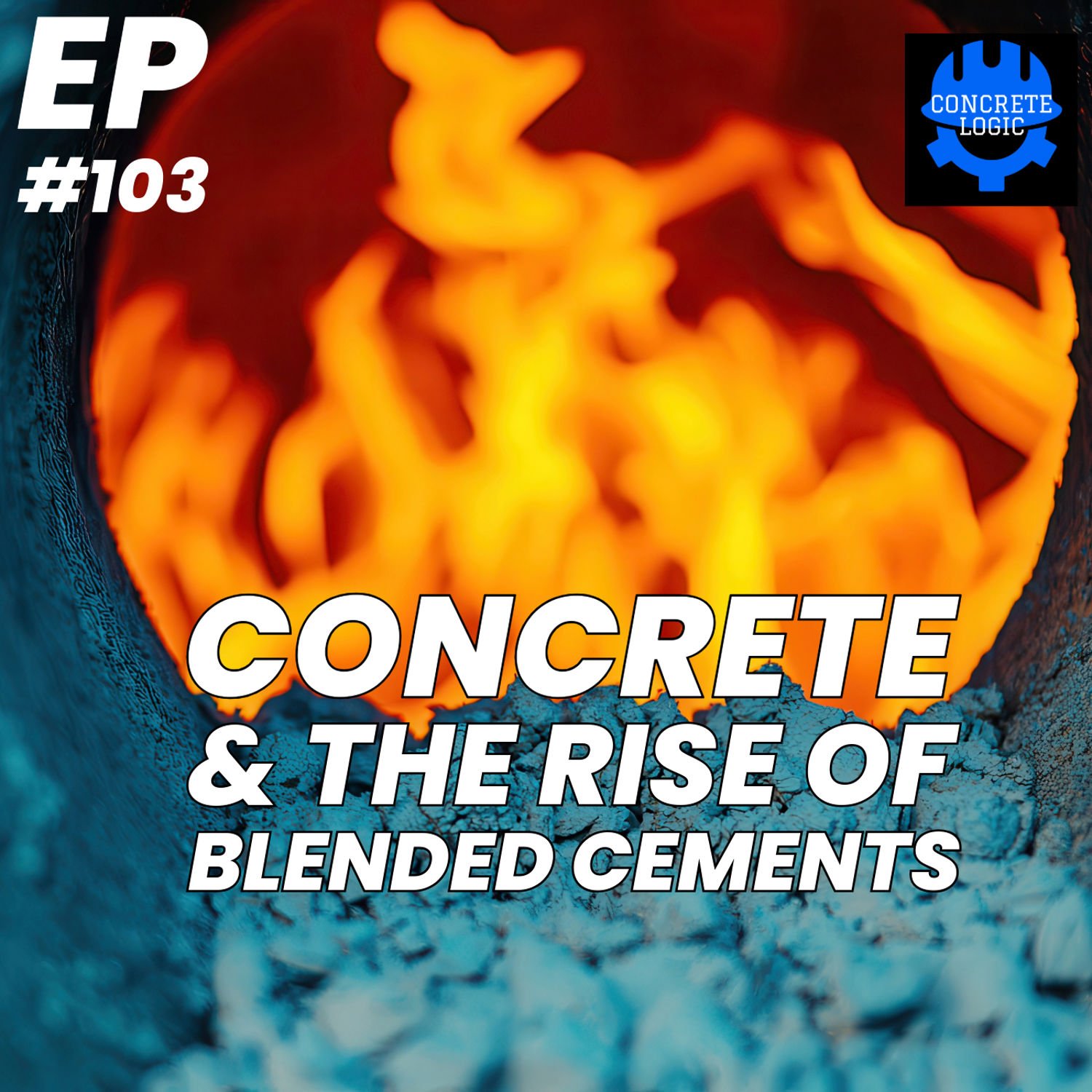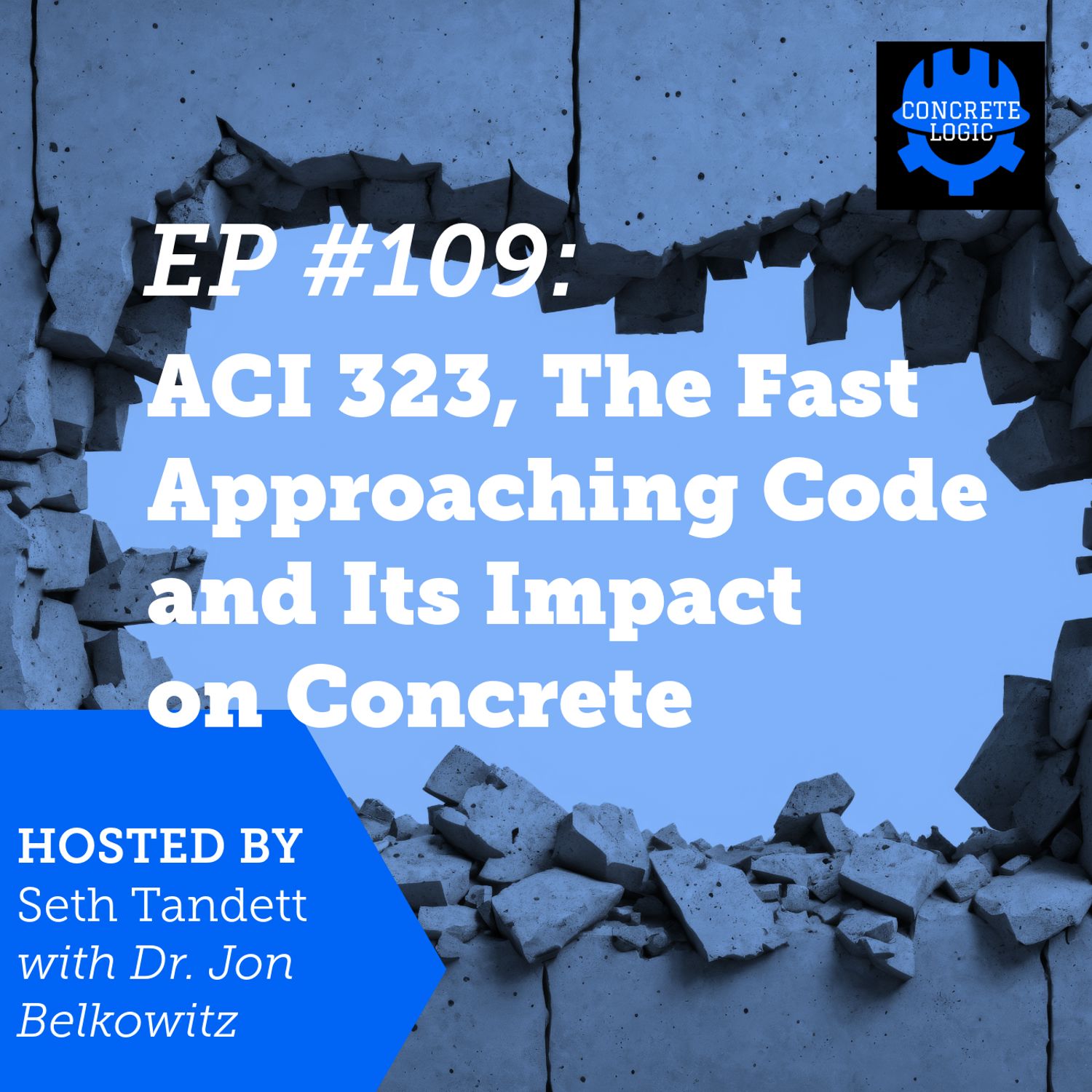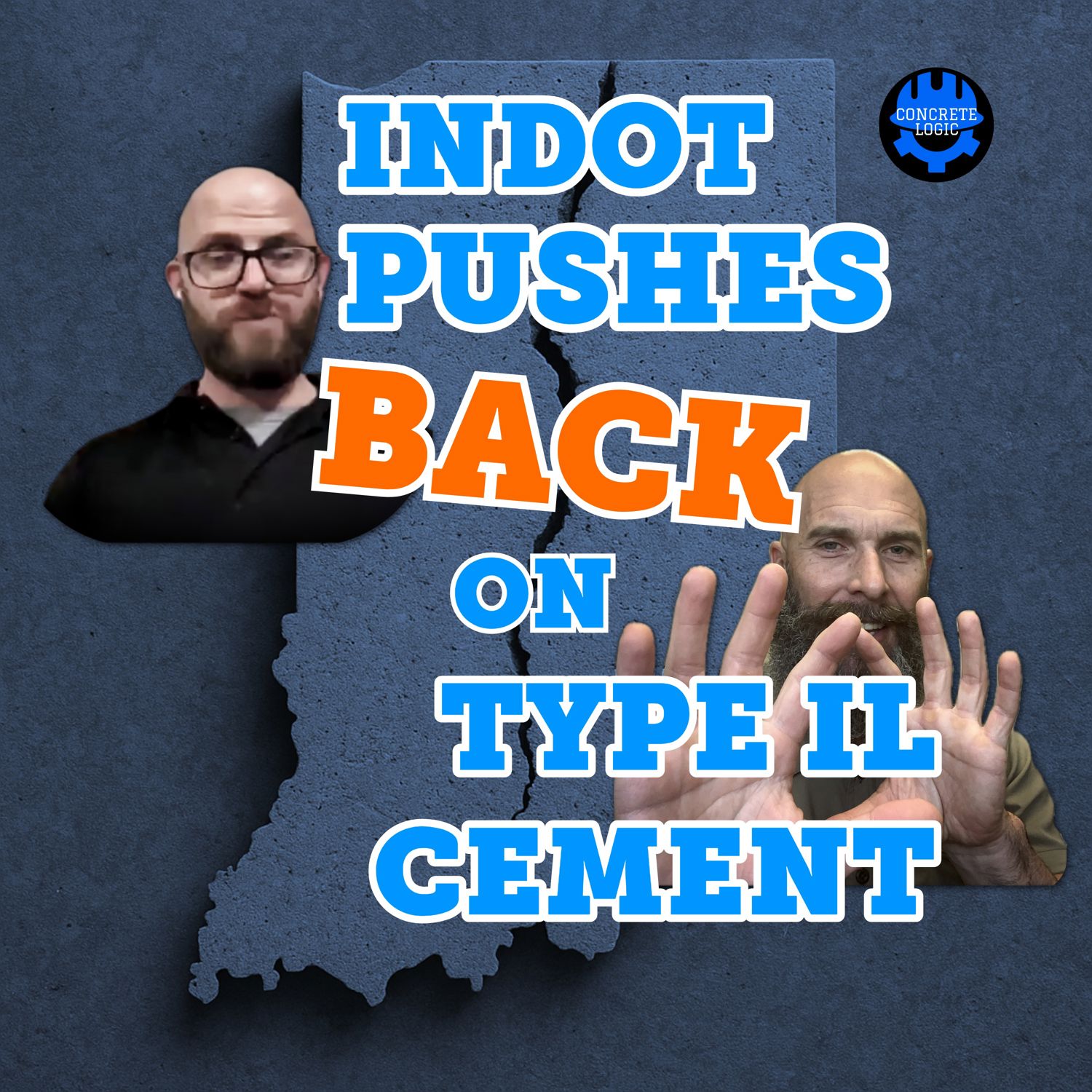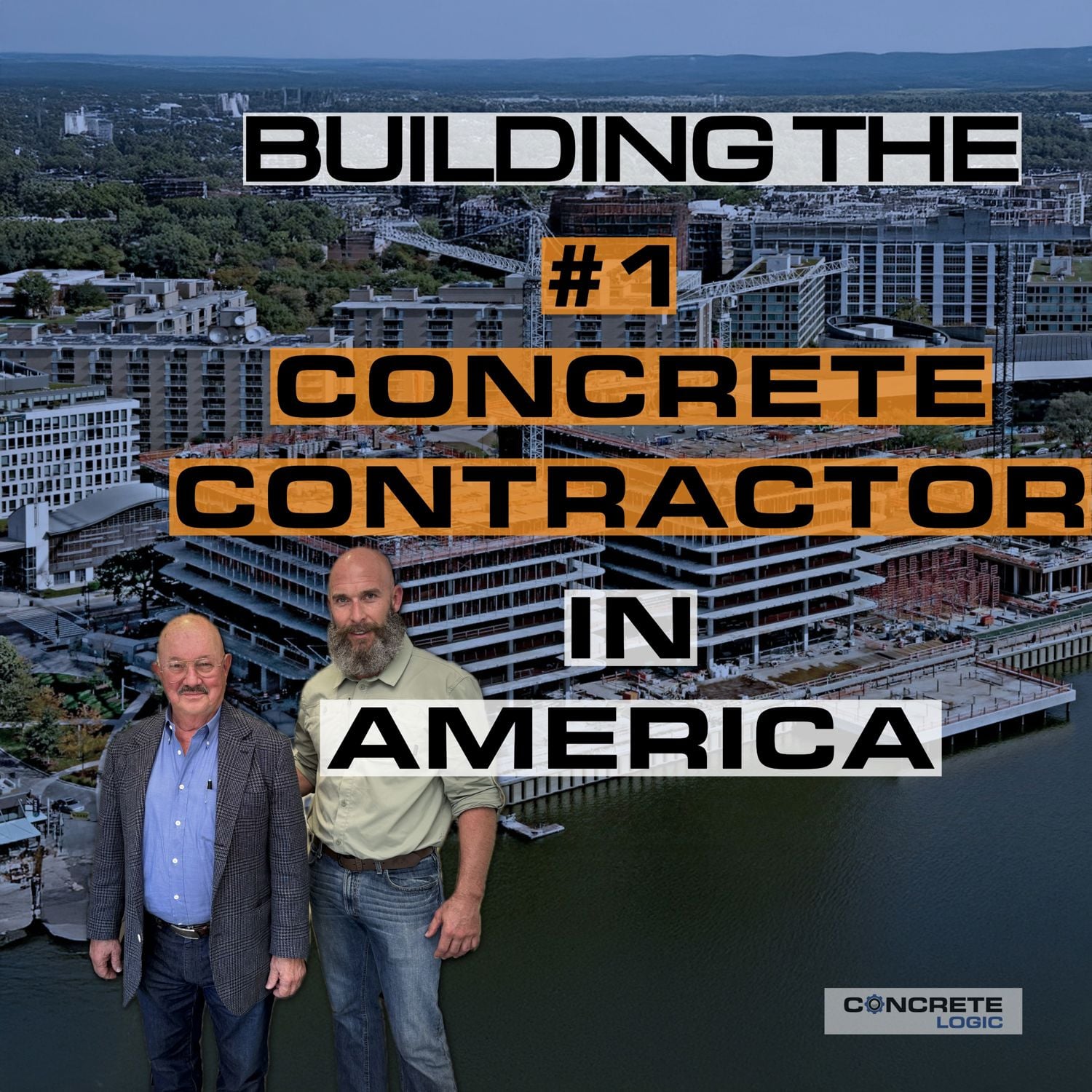EP #138: Is Low Rho Concrete the Hidden Key to Cooler, More Efficient Data Centers?

What if your concrete mix could cut a data center’s power bill by 15%?
In this episode of the Concrete Logic Podcast, host Seth Tandett talks with Frank Stankunas Sr., Frank Stankunas Jr., and James Cordeiro from Silverback Concrete about a concept most engineers haven’t thought about—thermal resistivity in concrete.
They explain how low rho concrete helps data centers shed heat faster, take pressure off the grid, and extend the life of buried electrical infrastructure. You’ll hear how they’re testing mixes that hit rho values in the 20s, why quality control is everything, and why engineers need to stop “copying and pasting” specs from old jobs.
By the end, you’ll see why thermal resistivity may be the next big efficiency play in the world’s fastest-growing utility - data.
What You’ll Learn
• What thermal resistivity (rho) actually measures in concrete.
• How low rho concrete reduces power bills and protects the grid.
• Why inconsistent mixes can cause “thermal runaway” in cables.
• How soil type and aggregate selection affect heat dissipation.
• What testing and verification look like for low rho concrete.
• Why some engineers are still unaware of rho’s importance.
• How Silverback’s “Game Changer” mix is redefining performance.
• What collaboration between engineers and contractors could unlock next.
Chapters
00:00 – Introduction to Thermal Resistivity in Concrete
01:48 – Understanding Thermal Resistivity and Its Importance
05:21 – Comparing Standard Concrete Mixes to Low Rho Concrete
09:08 – Testing and Verifying Thermal Resistivity
12:37 – Quality Control and Consistency in Concrete Mixes
16:22 – The Role of Engineers in Specifying Rho Values
20:05 – Innovative Approaches to Reducing Heat in Data Centers
23:37 – Conclusion and Future Directions for Concrete Technology
Guest Info
Frank Stankunas Sr. – President, Silverback Concrete
fstankunas@silverbackconcrete.co
Frank Stankunas Jr. – Vice President, Silverback Concrete
fstankunasjr@silverbackconcrete.co
James Cordeiro – Director of Strategic Development, Silverback Concrete
jcordeiro@silverbackconcrete.co
https://www.silverbackconcrete.co
Concrete Logic Academy
Earn your PDHs the logical way.
Explore practical courses made for contractors, engineers, and producers.
Free trial: https://www.concretelogicacademy.com
Support the Podcast
Support the show and be listed as a Producer for life on the episode page:
https://www.concretelogicpodcast.com/support
KUIU Affiliate Link: https://www.concretelogicpodcast.com/kuiu
Media & Sponsorship Inquiries: seth@concretelogicpodcast.com
Podcast Partners
Intelligent Concrete
At Intelligent Concrete, we combine lab precision with field expertise to help you understand what your concrete is telling you. Our services include mix troubleshooting, forensic and petrographic testing, performance-based specification and admixture development, and training for engineers, contractors, and producers.
Whether you’re chasing consistency, durability, or answers after a failure, Intelligent Concrete delivers the data and insight to solve problems and improve performance.
Learn more: https://www.concretelogicpodcast.com/intelligent-concrete
Credits
Produced by Jodi Tandett & Concrete Logic Media
Music by Mike Dunton — https://www.mdunton.com
Connectivity
Host: Seth Tandett
Concrete Visionary | Business Development at Baker Construction | Host of the #1 Concrete Podcast
LinkedIn: https://www.linkedin.com/in/sethtandett/
YouTube: https://www.youtube.com/@concretelogicpodcast
Website: https://www.concretelogicpodcast.com
If you learned something new, share this episode with your team and help more engineers and builders think logically about concrete.
Until next time, let’s keep it concrete!
Seth Tandett (00:00)
And welcome to another episode of the Concrete Logic Podcast. And today I have three gentlemen with me from Silverback Concrete. Frank Stankunas, he's president. Frank Stankunas Jr. is vice president. And James Cordero, director of strategic development, is with me today. And we're going to talk about thermal resistivity in concrete for data centers. This is a new topic for me personally.
I've ran across it on projects before, these fellows have been doing it for a while. So they got a lot of share and I promise you, you'll learn something today. Before we get into the topic, I just want to remind everybody to support the podcast. You hear the introduction, the lady tells you a couple ways you can support, but you need to hear it from me because you haven't heard it from me in a while, is to make sure you go to the ConcreteLogicPodcast.com website.
you can donate to the show and when you donate to the show, it's like you're, you're sponsoring or producing the show and I will, give you credit for doing that. your name, your, your company or you personally will be listed attached to that podcast episode and that'll be attached there for life. So make sure before you donate that you want your name attached to this podcast for life.
And then make sure you check out Concrete Logic Academy, ConcreteLogicAcademy.com. That's a good way for you engineers out there to get your PDHs so you don't have to do those boring courses that are out there. We all know what I'm talking about. You can sit there and a guy sits there and reads PowerPoint for an hour. So if you like listening to this podcast, the Academy's for you. So check that out. All right, fellas.
So we're going to talk about thermoresistivity and current create for data centers. Who wants to tell us what that is and what that means?
Silverback Concrete (01:48)
Well, thermal resistivity is how easily we can dissipate heat from the electrical power lines that are running from these sub power stations to the data center. So the idea is to remove as much heat as possible so the data can transfer quickly. So everybody can stream their Netflix and everybody can store their photos on their iPhones or their Android phones quickly and seamlessly. So it's really what we're trying to get out here. How easily and efficient.
Can we transfer power and remove that heat? Because a lot of heat is generated from these power lines. So we have a cool concrete that can help dissipate that. And it's also related to the soil for these power lines that are running into these data centers.
Seth Tandett (02:29)
Yeah, so that's kind of opposite of what we kind of think about when we think of concrete, right? Because it's kind of thermal keeps everything in. So what you're saying is that you design concrete that lets the heat dissipate.
Silverback Concrete (02:41)
That's right. That's right. Yeah. Frank, Frank Jr. is the engineer behind this and he can explain in a little more details. But generally speaking, yeah, you think about it. Concrete is a good conductor of cold and heat, but there's a special sauce that you can, you can utilize in a formula that'll help dissipate that heat in an efficient way. And it's very important.
now that these data centers are drawing so much power off the grid. So anything we can do to reduce the friction on that grid is super critical, especially with all of these data centers that are being built now.
Seth Tandett (03:17)
So can we compare a standard mix to what you all are doing as far as I guess we would call them targets, What's the measurement for thermal resistivity, I guess, to start with?
Silverback Concrete (03:31)
You want answer that? Yeah. Yeah. Your target is for a low row, you want typically it's 55. 55 is your low row and the higher the row, the more it's conducting heat. The lower the row, the more it's dissipating heat. So we, know, if your normal concrete is going to be sitting around anywhere from 70 to 120 row, depending on where you are in the nation.
your low row you're targeting 55 or under is what your goal is.
Seth Tandett (04:06)
Okay, and what is, like I said, this is all due to me. Frank Jr., you're have to put up with my dumb questions. So you say rho, what does that mean? Is that like temperature? What does that mean?
Silverback Concrete (04:11)
Yeah. Yeah.
It's just thermal resistivity is what it is. So how resistive your concrete is to the heat.
Seth Tandett (04:23)
Okay.
Okay. All right. So if I if.
Silverback Concrete (04:29)
It's
a mathematical formula. There's actually a formula that exists. It's the amount of heat that's dissipated per volume in the actual concrete. So there's a measurement that's been generated and they chose a fancy term, know, Greek letter rho, is where's the term comes from. It looks like a lowercase p, but they pronounce it R-H-O, right? So you'll see that.
Seth Tandett (04:39)
Okay.
⁓ huh.
Okay, yeah,
yeah, I did a quick search on this. I said, read up just enough to be dangerous. So, okay, so why...
Silverback Concrete (04:59)
Seth, I
would like to add the lower the row value, the lower that number, the less resistance on the power grid.
Seth Tandett (05:04)
Yeah.
Silverback Concrete (05:12)
which is the left, and your power bill comes down. It saves, we're saving 10 to 15 % of a power bill on a data center by using a low row concrete in the 30s. they have a 55 and we come in, Trace, what do we hit in Virginia? We have some at 29. Some 29, man, 29. So we're helping the grid. That's our whole goal is, you you look at the,
Seth Tandett (05:21)
⁓
Wow.
Silverback Concrete (05:42)
The grid and you hear about it, you read about it every day. We can talk about it right now. The towns don't want these data centers because of the power consumption. And we are helping the grid. And we're saving money for the owner. That's a fact. Those are facts.
Seth Tandett (05:56)
Yeah, that's cool.
That's what I was going to ask y'all. Why is this so important for the heat to dissipate from these? it sounds like it makes the power more efficient is what you're saying?
Silverback Concrete (06:08)
There's sound.
There's several reasons why. Why it matters? there's two things. It reduces the power grid. The restraint on the power grid is reduced. It's also extending your cable life. So if your cables only have a certain many, X certain many years of life expectancy, it's going to increase the life expectancy of those cables. And also you're reducing your construction costs by
So for instance, if your soil, the deeper you go in soil naturally, the lower row you're gonna get. if you're in a wet environment, a moist environment, it's compacted well, you're gonna be around 60 for your natural soil. Your dry soils will be around 120. Your average in America, which it's hard to say average because where are we, is around 90. But the deeper you go on your soil,
The deeper you go with your your duck bank, so if you're digging 20-14 feet You can save a lot of construction costs by using a low row concrete by only having to dig 5 to 10 feet instead of double what you're doing
Seth Tandett (07:16)
Yeah.
Yeah, that's really cool. So how do they test and verify the thermal resistivity of a mix? How do you do that?
Silverback Concrete (07:26)
Yeah, we have a third party engineering firm. So what we do when we go out to a new market is we go and we scour the area for one of the best raw materials we can use within a radius of that particular market area. And then we partner with a third party engineering firm where we go and Frank Jr. and the team design a mix based on the conditions of that area and the raw materials available.
And then they do their pressure testing and they do their stability testing on that material. So it'll be specifically designed for that particular market to handle the soil conditions and the climate conditions of that area. And then the needs of the power that are being run in from these substations out there. it's all under the guidance of, in this case, Silverback, but in partnership with a third party engineering firm, because that's how we're going to establish this as.
as the path going forward to utilize these low-row concrete because this is something the industry is aware of. They're aware of row as being a factor in this, but it's not quite there yet as far as being the standard on what's utilized in the power transmission because we transition from what people are accustomed to in data centers knowing about storage. Data centers have been around for a long time.
but it's been more about where we store information and what's commonly known as the cloud, where do we store it in the cloud. It's not physically a space in the air where the stuff is stored, it's just redundancy. Or multiple data centers will have the same data stored in different locations so you can preserve kind of in case there's any issue with one. But nowadays with...
all of this artificial intelligence and the agent AIs that everybody's becoming more familiar with, ChatGPT and Grok and Clod and Perplexity and a number of other companies that are utilizing these actively engaged artificial intelligence agents that are processing information, the power draw is dramatically increased. So the amount of power that's needed is substantial. So we're having this new mix designs
specifically catered to the markets in the areas based on the soil conditions and the raw materials. It's just, it's a game changer. that's when we came up with this and Frank and his team did it, that was what we ended up naming it, because we think it's a game changer for the industry.
Seth Tandett (09:51)
So there's not a standard for testing? Did I hear you right?
Silverback Concrete (09:56)
There is, yeah, it's standardized testing across the board. We just need to draw from the locally sourced raw materials from the area and the soil conditions that exist in that area. across the board, the engineering and the spec testing is standardized, absolutely.
Seth Tandett (10:12)
Okay, so how do they test it?
If it's not, it's not, they're not break, they're not breaking cylinders. So what are they doing to test the concrete?
Silverback Concrete (10:14)
That's from our staff.
Well, we use a company, SGS, which they're world renowned. so when we gather all the raw materials and we design these mixes, we might take five different sands from one region, five different rocks from that same region, the cement, our secret sauce that we add to it, and then we start playing with the formulas to test the low road to get that.
Seth Tandett (10:26)
huh.
Silverback Concrete (10:46)
that region, like when we went out to Phoenix, we're at 39 RHOs, that people don't even believe us hardly, because we just didn't grab the raw materials that was closest to our plant. We went all around in a 90-mile radius, grabbed the raw materials, and took back to our lab in Lawrenceville, Georgia, and created a mix for that region.
How they test it, I mean, they've got all these, you know, I mean, they test the way it's curing, they test the way the dissipation of the heat. I mean, they've got all these hot dollar, I mean, it's a laboratory, that they test our concrete on. there was only one that even competes with it.
Seth Tandett (11:26)
Yeah.
Silverback Concrete (11:35)
with us and it's a slurry mix. It's not even a concrete mix. It's like a, it's like a flowable field. And we're at a 3,500 PSI concrete mix and then we throw the red dye on top or either blend the red dye in with it. So 50 years from now, if they go to hit those power, you know, somebody's digging it up or whatever and they see it, they'll know it's danger.
Seth Tandett (11:41)
Right.
Yeah. So is there, you mentioned about curing it. Is there, do y'all need to cure it a special way? know, what cure these, these duck banks or anything like that?
Silverback Concrete (12:11)
Now
it sets up just like a footer would set up. It'll cure just like a footer would cure. Now, there's a lot in that. you have to control your bleed water. The density of your concrete matters. Your hydration, your moisture in the concrete, all of that. There's a special formula to try to meet this row, right? So that all does matter, absolutely.
Seth Tandett (12:16)
Okay.
Okay, so is it a... Are you trying to make the concrete more dense? Or less dense?
Silverback Concrete (12:44)
Denser
has a better row. That is yes.
Seth Tandett (12:47)
Okay.
And when you, I think you all make your own concrete, right? And you place the concrete you make. How do you make sure that the concrete that is delivered is what you need for that duck bank?
Silverback Concrete (12:53)
deserve.
Yeah, I'm glad you said that. So the quality and consistency of your concrete is very important. there's a main, there's a big reason for that. There's something called thermal runaway in your wires, your cables. So thermal runaway is when you have, let's just use soil for instance, if you're going from a compact wet soil at 60 row and then you have a dry spot at 120 row, well, all of your heat and your cable is going to be focused where?
It's going to be focused in the 120 row region. So same thing with your concrete dug banks. So if your concrete is row consistent and then you have a bad truck in there or you have a bad mud or you place non-row concrete in this dug bank, all your heat going to be focused in that one area. So your quality control team matters. Your water cement ratio has to be on like a true water cement ratio, not just what the plant says. The true water cement ratio matters.
The temperature of the concrete matters when it was loaded, when it was batched. There's certain, just won't batch concrete if it's too cold or if it's too hot for row concrete. So there's a huge aspect and formula to this whole ordeal.
Seth Tandett (14:15)
I gotcha. So high quality control standards for this mix. I gotcha.
Silverback Concrete (14:18)
All right, yes sir. But Seth,
here's what one of the problems we see in the industry is it's a copy and paste approach, These engineers, and no disrespect to them, but they're so busy on the backlog of business that they're just copy and pasting these. I mean, we go out there, we went out to Phoenix, and we're telling these guys that we know we're having issues, and they're not.
I mean, I don't know if they, don't, some of them don't even know what road means, man. And they're the engineers on the plans. They should know what low road means. They should know they should be looking at ways to, you know, I mean, we're trying to reduce the grid. And I was talking to a CEO of Ori Electric and he did a thesis on this and he's talking about, Frank, they need to take
three phase power, spin it together, run it through the duct banks, the way they do the conduit placement, because then you could reduce the heat another 15 % by doing that. Those are the things we need to be talking about and we need to be educating and need to come up with, because if I'm telling you we can take off 10 to 15 %
The way they put the wires in the conduit and place the conduit in the duct banks is another 15%. What does that do for the grid? You're gonna give me a Pulsar piece of award, man.
Seth Tandett (15:47)
Yeah. Yeah.
Yeah, yeah, hopefully less windmills and solar panels. so that leads, Frank, that leads me to my, I was getting to this question. So who usually specs the row on the job? Sounds like you guys are doing more educating than them educating you on what needs to happen on these jobs. they copy and pasting? ⁓
Silverback Concrete (15:53)
It's real.
Yeah.
Go
ahead, Mark.
Seth Tandett (16:18)
pasting what they had from
job to job or?
Silverback Concrete (16:22)
Yes sir, so typically on all the submittals and mix designs that I've seen that, you know, in their specs, it's 55 row is what they want. They want a 55 RHO. I think it's 65. It depends on the region. So, yeah, it depends on your region. East, you're looking at 55, 60, and then west you're looking at 65, 60.
Seth Tandett (16:32)
Yeah.
And that's, is it, yeah. Is it coming from the electrical engineer or the structural engineer? Where do you find that in the spec?
Silverback Concrete (16:48)
It is a copy and It's a copy and paste.
I've seen it on both actually. It's coming from electrical engineers and the general engineer.
Seth Tandett (17:05)
Gotcha. there, I mean, we're just pouring duck bank, but as the row gets lower, is there any impact on workability of the mix? No? No issues with?
Silverback Concrete (17:17)
Of the mix itself? No. Not at all. Yeah. It looks,
it'll look just like normal concrete. Now, typically you're going to want to pour it at a three and a half, four inch slump is what I like to stay between for us. But you know, you know how these guys are. They want to add 20 gallons of water in it and you just can't do that. Yeah.
Seth Tandett (17:37)
Yeah. Yeah.
And are you truck dumping? you pumping it or a little bit of both? Both? Okay. I assume the lower the row gets, the more expensive it gets. Is that true statement?
Silverback Concrete (17:43)
We both. We do both.
That is a very true statement. A lot of it has to do with expensive aggregate that's, you know, you're to, reducing heat aggregate. So aggregate that dissipates the heat rather than controls the heat and holds that heat in.
Yeah, and getting to the point of that is, you know, the upfront construction costs we can impact. Yes, the price of the concrete is higher, but the amount of concrete potentially less, so it's offset in that case. So we impact the construction costs, but we've also been talking about the recurrent, the long-term, you know, recurring expensive of utilities on this. We're impacting that side of it as well. So.
as Frank was saying, about a way to work with the cables to reduce the thermal resistivity as well as the concrete we're impacting in this way. So it's something we're talking more upstream now. When getting into the building specs with this concept and working with the engineers beforehand, we've been pulled into these conversations now because of the work we've been doing with our partners in Virginia and getting really good feedback.
that this is an important conversation to have more upstream to bring this concept of Roe and potentially doing something better or something novel, right? Because I love the name of your podcast. It's concrete logic, right? So being logical about this, where do we start? We start with the basic principles are, why are we doing these things this way?
I don't know, it's just been done that way. Well, that's not a good enough answer for me. I want to know the real reason. Is that the right way? Is that the best efficient way we should be doing it? So that's what the team does here and why we've been able to come up with this. But being involved in those projects has really, really opened up the conversation in this and it's worked out really well for us to expand our operations now out to the southwest, which the soil out there.
if you don't know, out in the high desert out there in Arizona, the soil is very dry, very dry out there. the fact that we've been able to work within that environment and generate a similar row as we did in Virginia is a very good sign. And people are becoming more aware of it as we're able to have these conversations. So Seth, and another thing to piggyback.
Seth Tandett (20:05)
Yeah.
Silverback Concrete (20:07)
you know, if you look at a set of plans, most of the three-phase wire runs parallel to each other. That that's creating, we feel it's creating more heat. What we would like to, I mean, I'm not an electrical engineer, but they need to do some tests because we feel if you take those three-phase power, twist them together, that the electromagnetic fields, by doing that, it will offset and cancel each other out.
And then that way, I mean, by if you cancel the heat, then that's where you're going to pick up your savings. Less heat, faster flow. Yeah. Yeah. Cause we're definitely hitting, we've been talking about power here, but the real, the real thing we're talking about is telecommunication. So the actual transfer of data information, that's, that's where we're trying to hit with these power, these power savings is that.
Seth Tandett (20:40)
Yeah, that's.
Silverback Concrete (20:58)
the latency, this term called latency, which is how fast something can pass through these cables. So there's not a delay, right? Because I made a joke earlier about Netflix or our phones and everything, but so many things are controlled by these software programs. So we don't want to lose anything in the transmission of that data and information because our power grids, our utility grids, our...
airplanes, our cars, our infrastructure is all run by these systems now. it's a mission critical as you, I'm sure you appreciate being in the concrete world and data centers that this is the fifth utility, know, the way that it's being described. Now these data centers are actually a national utility. So it's a priority that we focus on being the most effective and efficient to maintain these are operating 24 seven, 365.
Seth Tandett (21:51)
Yeah.
Silverback Concrete (21:51)
They're
never offline.
Seth Tandett (21:54)
It sounds like from the success you all had thus far is because they have, I guess, told you what row they want, know, what low row they want, and you all come up with your mix design based on that requirement versus a prescriptive design, which they would tell you what to put in the concrete, right? With that,
experience so far, it doesn't sound like there's a there's not an ACI standard for this, right? Is that correct?
Silverback Concrete (22:25)
So Seth, there is, we were in the specs. It's a 3500 PSI 55 RHO is what they want you to hit. And so we will make that mix because it's less expensive. Because if the owner hasn't gotten the news that, hey man, then we'll make them two mixes. We'll make them just one for specs and then we'll make them our game changer mix. The game changer mix.
Seth Tandett (22:35)
Okay.
Okay.
Silverback Concrete (22:53)
It cost us more money, so it cost the owner more money, but the fact of the matter is, it really saves them money in the long term. If we save 10 % of the power bill or 12 % of the power bill a month, what does that look like on a 46 megawatt building? And then you times that times 100, that's, you know, we should double the price of the low-flow concrete. I mean, that's astronomical amounts of savings in the long run.
Seth Tandett (23:09)
Yeah.
Right.
Silverback Concrete (23:23)
Initially it cost more money, the like the wear and tear on the wires, the power bill for the next 40 years. I mean, we say that's, so it's a two thing, we're saving real, real money to the owners by using a low road concrete. Less heat, better problems, man.
Seth Tandett (23:37)
Yeah.
Yeah, no, this was very eye opening for me. Like I said, this is new to me. I haven't spent a lot of time on learning about the resistivity of concrete. It was usually like, that duck bank stuff is for the electricians, right?
Silverback Concrete (23:59)
Yeah.
Seth Tandett (24:00)
is there anything else do you guys want to share before we, wrap it up today?
Silverback Concrete (24:05)
Well, just, you know, I would just like to encourage these, an electrical, somebody, engineer to, to really, really look at the conduit placement, the electromagnetic field cancellation, the, the way we backfill, I mean, EMF is electro motive force and electromagnetic field. I mean, those are.
So, electromotive force, it's the energy per unit charged supplied by a voltage source to drive electric current. And the electromagnetic field is a combination of the electric and magnetic fields. I mean, this is all high tech stuff, but if we could somehow let these wires offset each other instead of... Because when you run them parallel, it's creating a lot of heat, man. It's a lot of heat.
And that done.
Seth Tandett (25:02)
Yeah.
Silverback Concrete (25:03)
And somehow the way we place the conduit, now they're big studies. mean, we're just having a little podcast here. I know. Yeah. And Seth, I want to thank you for giving us this opportunity. This is really cool that we're able to talk to you about this. And what we're really looking to do is build long-term strategic partnerships with the electrical engineers and architectural engineers, mechanical engineers, as well as the GCs and the owners.
on these buildings. So, you know, we like to have conversations and see what's possible because I told Frank, he may not believe it, but I think he's becoming like, we're a bit of a tech company. You know, we've got technology here that we're working with and the concrete industry is the second most utilized resource in the world next to water. So concrete is a very important component of our society. And so if there's anything we can do to bring
bring all of the players together and discuss, what's a better way to build something more efficient and effective, especially during this new race, right? This is essentially a new race with the race to achieve artificial intelligence and be the kind of the world leader in this. And the United States is in a good place to be that leader, but we got to work together. And that's always what we're looking to do is how do we build strategic partnerships throughout the US so we can.
We can get the message out and we can get other people more familiar with the possibilities of working with something like Silverback's Game Changer Cool Concrete Mix Design. So we're happy to have a chat if people want to reach out and we can share our contact information with y'all and have it in the notes there as well.
Seth Tandett (26:49)
Yeah, I'd be really interested to see the savings or the power efficiency from standard, you know, whatever spec to, you know, to what you all come up with and the savings, the energy savings there, which again would roll right into, you know, reducing the carbon footprint of a data center, which is what all these data center owners are concerned about.
on top of what you mentioned earlier was the energy use that the data centers have and how that impacts surrounding communities. Everyone's worried that data center drops near their home, that their electrical bill is gonna go sky high. So, mean, again, it's, this is a,
Like I said, this was a great, I thought this was a great episode with you guys. I think there's a lot more to talk about and we could get some other folks involved and have a more expansive conversation on how this can help not just the data centers, but the community itself. With that, Frank.
And Frank Jr. Do you guys want to share how folks can reach out to you to learn more?
Silverback Concrete (28:00)
So I'm Frank Stankounis. They can catch me by my email. It's fstankounis at silverbackconcrete.co.co. That's my email address. That's probably the easiest way. And Seth, I would like to say that.
One more thing is we would be willing to license this. We'll go to a region, we don't have to just move a plant there and take over. We will go make a mix design for that region and then let them run our mix designs. We would do that for anywhere in the United States. We're looking at a couple of locations now. And that's not that I'm just gonna come over there and put a ready mix plant, take over the job. We will come over there and make a mix design and then license it to the local ready mix suppliers.
We will do that.
Seth Tandett (28:44)
Yeah, that's a fantastic
idea. Frank Jr. How do we reach out to you?
Silverback Concrete (28:49)
Yes, sir. my email is pretty much saying it's F or FrankstankunisJR at silverbackconcrete.co. F Stankunis. Yeah. ⁓ yeah. Sorry. Correct. Stankunis. F StankunisJR at silverbackconcrete.co.
Seth Tandett (29:00)
We'll get, don't worry about it. I'll get it right. I'll make sure I get it right in the show notes. James,
how about you? they reach out to you?
Silverback Concrete (29:12)
Yeah, we have the same format. So it's my first letter, name Jay and last name Cordero at silverbackconcrete.co. You can also check us out at silverbackconcrete.co online as well. We have a website set up there and some social media presence through the website.
Seth Tandett (29:28)
Yeah, so I thought this was a great episode, guys, a great introduction to the thermal resistivity of concrete and data centers. Appreciate you coming on the show. And folks, until next time, let's keep it concrete.
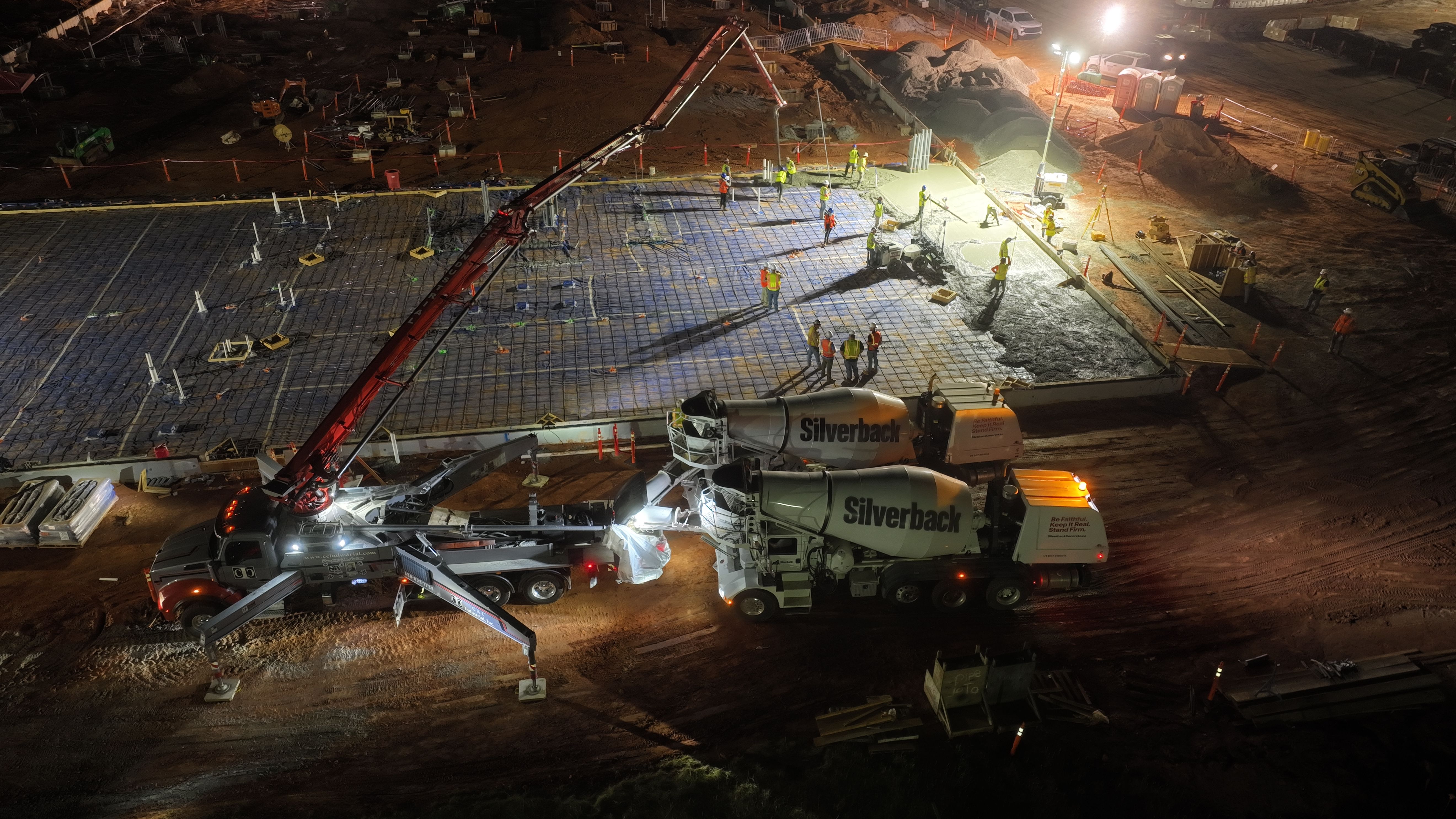
President
Silverback has been a Business Family from day one. In November 1996, Frank Stankunas founded Stankunas Concrete. His father, Frank Sr., joined the team in 1999 after retiring from positions as superintendent of Suwannee County Schools and principal of Lakewood High School in North Florida.
During high school, Frank’s three sons began working every Saturday setting up job sites and performing odd jobs. Today, all three Stankunas boys work in construction, where Frank III (Trace), Tyler and Hayden are full-time members of the Silverback team.
The common thread in all three generations has been a love of hard work and the simple pleasure of being outside every day. Our greatest satisfaction comes from the knowledge that when a building is finished and people move in, they stand on a firmly-built, rock-solid foundation.











